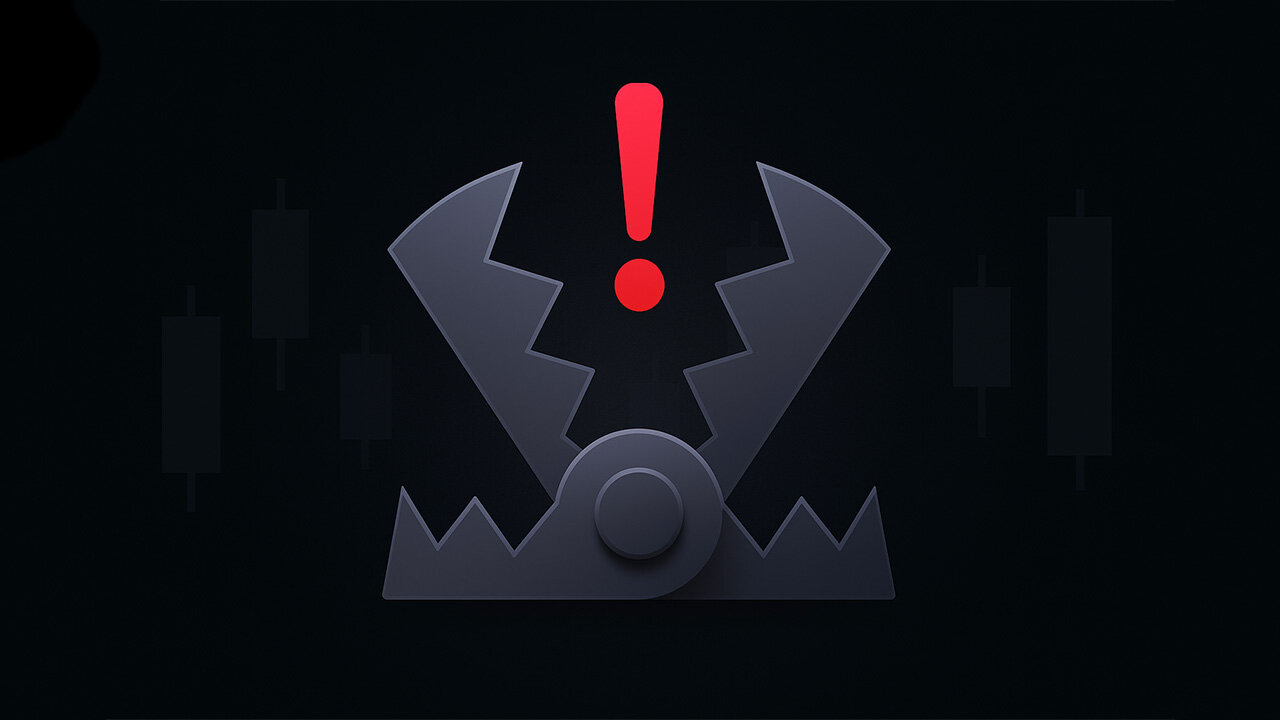We share verified earning schemes daily on Telegram.
In our Telegram channel, you'll find crypto signals, insider info on HYIPs, combo deals for tappers, and coin giveaways. Only verified earning methods without fluff.
It is no secret that the cryptocurrency market is volatile and sensitive to various factors, including the news background, actions of large players, and the mutual influence of different assets on prices. Based on this, one can conclude that the market is manipulative, and therefore traders or investors are misled by so-called traps that lead to wrong decisions.
In this article, we will discuss common traps for cryptocurrency traders and provide recommendations on how to avoid them.
What Are Trader Traps and Why Are They Dangerous
Traps in the crypto market are moments when you seem to have understood everything correctly, but the price suddenly moves against you. Traders fall into such situations due to fake signals, manipulations by whales, or simply emotions. This happens especially often when the market is jittery and there is almost no time for sober assessment.
These kinds of mistakes are dangerous for several reasons:
- Financial losses. Emotion-driven trades are most often unprofitable.
- Waste of time and resources. Making wrong decisions and analyzing them sets you back as if rewinding, and also distracts from long-term planning.
- Psychological pressure. A few losing trades and you stop believing in yourself, enter the next trade in panic or, on the contrary, fear to press the button. This leads to new mistakes. Simply put, a series of losses undermines a trader’s confidence.
Understanding the nature and logic of traps, as well as their potential consequences, will help you develop a more resilient market behavior strategy. Also, don’t forget to follow risk management rules and objectively assess what is happening — this will allow you to minimize the impact of such situations and protect your capital.
Psychological Traps: How Emotions Drain Deposits
Emotions are a trader’s main enemy. They make you jump into the market without a plan, ignore your own strategy, and then regret it. When fear or greed kicks in, logic switches off. You start trading not based on analysis but on a gut feeling, and most often — at a loss.
Even if you have a clear plan and a working strategy, stress can easily throw them out the window. The body reacts to the market as if it were a threat: "run," "fight," "escape." And the market takes advantage of this — snapping the trap shut.
That’s why it’s so important to control your emotions and not give in to the first impulses. If you don’t manage your emotions — the market will manage your deposit.
FOMO: How Fear of Missing Out Leads to Mistakes
FOMO (Fear of Missing Out) is that moment when the market suddenly rises, everyone starts entering, and your fingers itch: “I have to enter now — otherwise the train has left!” Your mind is noisy, logic is zero, you just want to make it in time. The result is entry without analysis, followed by a pullback and a loss in your balance.
This state is a result of information overload and crowd pressure. Everyone is doing something, and it feels like you’re the only one left out. So you jump in until the market punishes you.
How not to get caught? It’s simple:
- filter signals;
- watch volumes;
- check levels;
- look at the RSI indicator — if overbought, be cautious.
Better not to enter than to enter at a loss.
Greed and Chasing Trades
Greed is when you see a coin already up +20%, and you still want to jump in to grab a piece. Although, in fact, the train has already left. Traders in such moments forget about analysis and open a trade just because "everything is rising."
Most often this ends with entering at the peak and exiting at a loss when the correction begins. No signals, no plan — just because you didn’t want to "miss the moment."
How to fight this? A well-thought-out plan solves everything. For example, take partial profits at +10–12% growth, and you can withdraw the initial deposit right away — then even if the market reverses, you are already in profit and can keep a cool head.
Chasing Losses: When a Loss Turns Into an Even Bigger Loss
One of the most dangerous traps is the desire to immediately recover what was lost. Lost $200? Your hands itch to get it back in the next trade. Gambling kicks in: leverage increases, volume grows, you forget the strategy — and this is no longer trading but a casino.
Classic case: a trader enters the next trade with ×20 leverage just to "recover." The market reverses — and you lose not $200 but several times more. This is the path to complete deposit drawdown.
To avoid falling into this pit, you need discipline. Don’t risk more than 1–2% of your bankroll on a single trade. And if you catch a losing streak — just take a break. Sometimes it’s better to rest than to try to get the money back at any cost and lose even more.
Emotional Attachment to an Asset
A common trader mistake is falling in love with an asset. Instead of following cold calculation, a person keeps holding a position because they “believe” in growth. Even when the chart is already turning and the market gives all signals to exit.
Such attachment leads to accumulating losses, and the trade turns into a hope for a miracle. To avoid this, set automatic orders and write a clear exit plan in advance.
One working approach is the "first third" rule: if the price falls by 30%, lock in part of the position. This saves you from a full loss and helps maintain composure going forward.
Technical Traps: When the Chart Lies
Technical analysis is a powerful tool, but it can also let you down. Especially in crypto, where the market often behaves unpredictably. RSI, MACD, Bollinger Bands, volumes — all these can give false signals if whales enter the market or sudden pumps/dumps begin.
Traders fall into traps when they blindly trust indicators without considering the context. Manipulations, low liquidity, and panic — all this easily throws even the clearest technique off track.
To avoid getting caught out — don’t rely on a single signal. Look at the bigger picture, use confirmations, and remember that the market is not always logic but often a game of nerves.
Bull Trap
A bull trap is a false breakout of a resistance level that creates the illusion of the beginning of an upward trend. Many traders see this as a signal to enter long, but most often a sharp decline follows the rise.
The key mistake is ignoring volume. A real impulse must be accompanied by volume growth. If the breakout occurs on low liquidity — this is a reason to be cautious.
What to do:
- compare indicator signals with volume data;
- watch the price reaction after the breakout: is there an impulse or is the price stalling;
- avoid entering the market on the first move — wait for confirmation.
When volumes don’t confirm the signal, it’s better to lower your confidence and consider alternative scenarios.
Bear Trap
A bear trap is a false breakout of a support level downward. It seems like the market will collapse — traders open shorts, but the price suddenly reverses upward. The result — losses.
What to do:
- watch key support/resistance levels;
- confirm reversal on lower timeframes;
- don’t rush to enter — wait for volume and candle confirmation.
Indicator Overload
When there are 5+ indicators on the chart — chaos begins. One gives an entry signal, another — exit. This results in analysis paralysis and emotional trades.
What to do:
- choose 2–3 key tools (e.g., RSI + volumes);
- work according to your system;
- don’t chase every signal — less is more.
Market Traps: Whale Manipulations and External Factors
The market can suddenly break any analysis if large players enter the game or disinformation spreads. Even a clear indicator signal won’t work if there is news dumping or volume draining in the background. Such situations confuse retail traders, provoking wrong entries and sharp moves against the crowd.
In unstable conditions, it is important to consider the context — who might be behind the move, how organic it looks, and if there is volume confirmation. Without this, even a correctly read chart can turn into a trap.
Pump and Dump
The "pump and dump" scheme remains one of the most common forms of market manipulation. The mechanism involves artificially inflating prices through coordinated buying, after which organizers sell accumulated assets. The subsequent correction usually leads to losses for retail traders whose attention was caught by the rapid rise.
Liquidity and trading volume analysis is a key tool for spotting potentially dangerous assets. Avoid assets with low market capitalization and pay attention to order book depth and volume stability.
Fake News and FUD
FUD (Fear, Uncertainty, Doubt) is characterized by the spread of false or distorted information, leading to panic selling. In the fast-paced exchange of information via social networks and messengers, rumors and unverified data can cause instant sharp market movements, often without fundamental basis.
To prevent the negative impact of FUD, use several independent sources of information and verify data received. Critical perception of news significantly reduces the risk of falling into misinformation traps.
Whale Manipulations
Manipulative actions by large asset holders (whales) are widespread in volatile and low-liquidity markets. Such participants may place large orders creating the illusion of a sharp trend change, which triggers trading algorithms and provokes retail traders to open unprofitable positions.
To detect manipulations, you can use specialized on-chain data monitoring platforms — Glassnode or Dune Analytics, as well as services like Whale Alert, which immediately detect abnormal trade volumes and large transactions.
How Not to Fall Into a Trap: Recommendations
Avoiding traps in cryptocurrency trading is based on a systematic approach to risk management, discipline, and critical perception of market information. The measures below help minimize the impact of market, technical, and psychological factors:
- Work with a larger timeframe — daily and weekly charts produce less noise and fewer traps.
- Watch volumes — breakout without volume = trap.
- Use 2–3 indicators — volumes + RSI or candlestick analysis — a filter against extra noise.
- Include risk management — stop-loss and take-profit should be set in advance.
- Critically assess news — don’t panic at headlines, check the source.
- Analyze on-chain data and whale activity — large transactions may predict price movement.
Consistent application of these recommendations allows you to build a more reliable and reasoned trading strategy, reducing the influence of spontaneous and emotional decisions on the outcome.
Real Cases: Lost Millions
Analysis of market events in 2025 shows that even experienced participants can fall into traps without critical information evaluation and with an emotional approach to trading. Here are three illustrative cases reflecting the most common error scenarios.
Conclusion
Traps are a mirror reflection of the market: it seems the trend is reversing, but it is only an illusion. To avoid being among them, you need: volume filtering, discipline, sound analysis, and emotional control. Plan + risk management are your keys out of this labyrinth. And remember: not every jump on a fake signal is worth your deposit.
Basic principles — timeframes, volumes, stops — allow you to build a defensive line against traps. But the market mood is often changed by large players and news. So stay alert — and keep your finger on the pulse.
In this article, we reviewed the most common trading traps and pointed out how to avoid them.
Don’t fall into traps and make profits trading cryptocurrencies. If you have questions — feel free to ask, we are always happy to help.









Information
Users of Гости are not allowed to comment this publication.